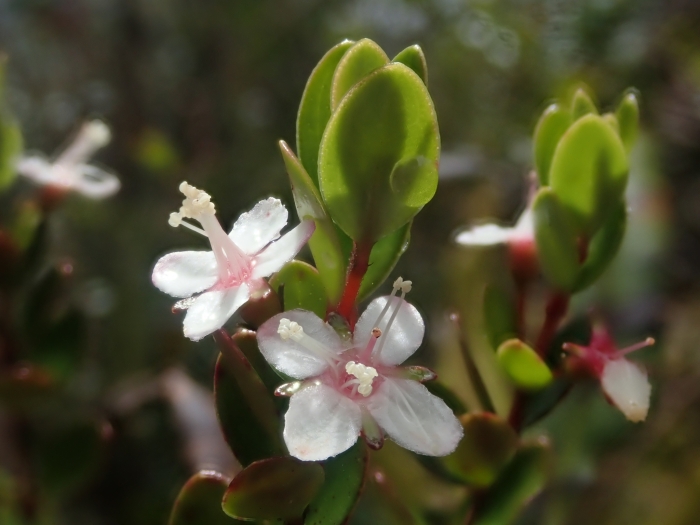Cranberry-Myrtle
(Myrteola nummularia)
Cranberry-Myrtle (Myrteola nummularia)
/
/

Nolan Exe
CC BY 4.0
Image By:
Nolan Exe
Recorded By:
Copyright:
CC BY 4.0
Copyright Notice:
Photo by: Nolan Exe | License Type: CC BY 4.0 | License URL: http://creativecommons.org/licenses/by/4.0/ | Rights Holder: Nolan Exe | Publisher: iNaturalist | Date Created: 2019-12-13T07:59:12-08:00 |



















Estimated Native Range
Summary
Myrteola nummularia, commonly known as Cranberry-Myrtle, is an evergreen shrub native to the temperate rainforests, peat bogs, and scrublands of South America. This low-growing plant typically reaches a height of 0.3-2 feet (0.09-0.6 meters) and spreads 2-3 feet (0.6-0.9 meters) wide, forming dense mats that can serve as an effective ground cover. The small, rounded leaves are glossy and aromatic, contributing to its ornamental value. During the summer, Cranberry-Myrtle produces an abundance of small, white, bell-shaped flowers that are subtly showy and attract pollinators. Following flowering, it bears edible, cranberry-like red berries that are both a visual treat and a source of food for wildlife.
Cranberry-Myrtle is valued for its low maintenance requirements and its ability to thrive in a variety of conditions, making it suitable for rock gardens, alpine gardens, and as a ground cover in temperate landscapes. It is also used for its edible berries in culinary applications, such as in the preparation of jams or liquors. For optimal growth, it prefers full sun to part shade and can tolerate low to medium water conditions once established. It is adaptable to different soil types, provided they have medium drainage. While generally disease-resistant, it can be susceptible to root rot in overly wet conditions. Gardeners should be mindful of its potential to spread, though it is not typically invasive outside its native range.CC BY-SA 4.0
Cranberry-Myrtle is valued for its low maintenance requirements and its ability to thrive in a variety of conditions, making it suitable for rock gardens, alpine gardens, and as a ground cover in temperate landscapes. It is also used for its edible berries in culinary applications, such as in the preparation of jams or liquors. For optimal growth, it prefers full sun to part shade and can tolerate low to medium water conditions once established. It is adaptable to different soil types, provided they have medium drainage. While generally disease-resistant, it can be susceptible to root rot in overly wet conditions. Gardeners should be mindful of its potential to spread, though it is not typically invasive outside its native range.CC BY-SA 4.0
Plant Description
- Plant Type: Shrub
- Height: 0.3-1.5 feet
- Width: 2-3 feet
- Growth Rate: Slow
- Flower Color: White
- Flowering Season: Summer
- Leaf Retention: Evergreen
Growth Requirements
- Sun: Full Sun, Part Shade
- Water: Low, Medium
- Drainage: Medium
Common Uses
Edible*Disclaimer: Easyscape's listed plant edibility is for informational use. Always verify the safety and proper identification of any plant before consumption., Low Maintenance
Natural Habitat
native to the temperate rainforests, peat bogs, and scrublands of South America
Other Names
Common Names: Teaberry, Huarapo, Ñaurapo, Daudapo
Scientific Names: , Myrteola nummularia, Myrtus nummularia, Myrteola oxycoccoides, Myrtus leucomyrtillus, Myrteola barneoudii, Myrteola nummularia var. barneoudii, Myrtus vaccinioides, Myrteola leucomyrtillus, Myrteola vaccinioides
GBIF Accepted Name: Myrteola nummularia (Poir.) O.Berg